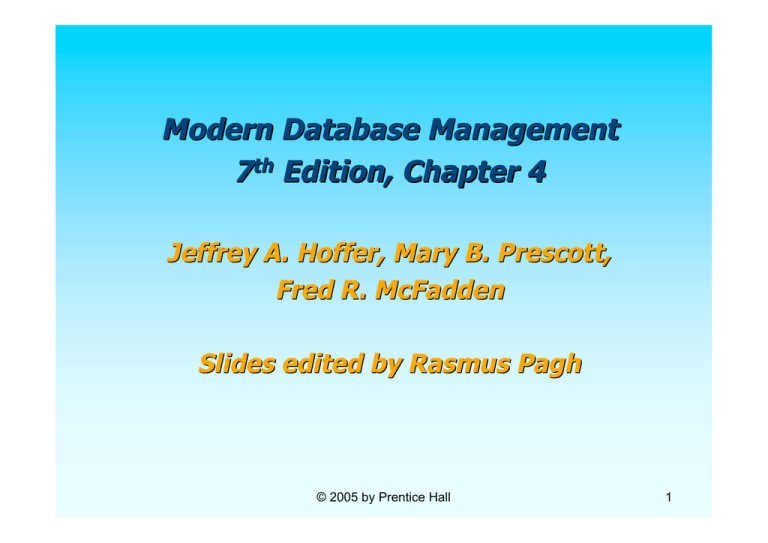Modern Database Management 7th Edition, Chapter 4
advertisement

Modern Database Management 7th Edition, Chapter 4 Jeffrey A. Hoffer, Mary B. Prescott, Fred R. McFadden Slides edited by Rasmus Pagh © 2005 by Prentice Hall 1 Chapter 4 © 2005 by Prentice Hall 2 Figure 4-2 – Employee supertype with three subtypes All employee subtypes will have emp nbr, name, address, and date-hired Each employee subtype will also have its own attributes Chapter 4 © 2005 by Prentice Hall 3 Figure 4-3 – Supertype/subtype relationships in a hospital Both outpatients and resident patients are cared for by a responsible physician Only resident patients are assigned to a bed Chapter 4 © 2005 by Prentice Hall 4 Figure 4-6a – Examples of completeness constraints Total specialization rule A patient must be either an outpatient or a resident patient Chapter 4 © 2005 by Prentice Hall 5 Figure 4-6b – Partial specialization rule A vehicle could be a car, a truck, or neither Chapter 4 © 2005 by Prentice Hall 6 Figure 4-7a – Examples of disjointness constraints Disjoint rule A patient can either be outpatient or resident, but not both Chapter 4 © 2005 by Prentice Hall 7 Figure 4-7b Overlap rule A part may be both purchased and manufactured Chapter 4 © 2005 by Prentice Hall 8 Figure 4-8 – Introducing a subtype discriminator (disjoint rule) A simple attribute with different possible values indicating the subtype Chapter 4 © 2005 by Prentice Hall 9 Figure 4-9 – Subtype discriminator (overlap rule) A composite attribute with sub-attributes indicating “yes” or “no” to determine whether it is of each subtype Chapter 4 © 2005 by Prentice Hall 10 Chapter 4 © 2005 by Prentice Hall 11 Figure 4-13a – Possible entity clusters for Pine Valley Furniture Related groups of entities could become clusters Chapter 4 © 2005 by Prentice Hall 12 Figure 4-13b – EER diagram of PVF entity clusters More readable, isn’t it? Chapter 4 © 2005 by Prentice Hall 13




